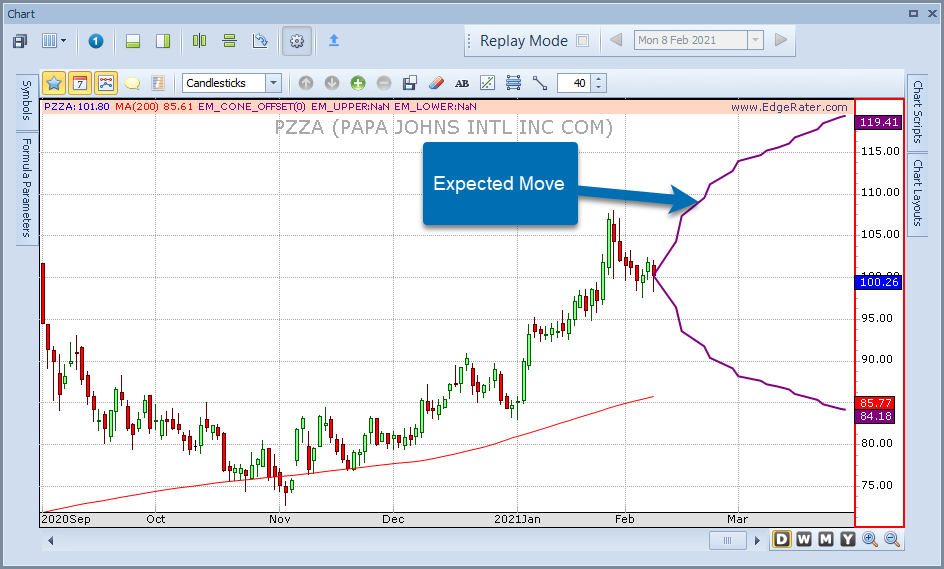
What is Expected Move?
A stock’s expected move is a price range that a stock is expected to be within on a future date suggested by a stock’s option prices. Price is expected to be within those levels 68% of the time. 68% is a one standard deviation move based on implied volatility.
Implied volatility is calculated using a stock’s option prices. a popular implied volatility number is the $VIX which is the 30 day implied volatility of the S&P500 index. However each individual stock that has options has its own implied volatility number for each option expiration date.
Plotting Expected Move
EdgeRater has developed an indicator called EM Bands (Expected Move Bands) that perform the expected move calculation based on Implied volatility and are plotted on a chart offset to the bar that the move applies to. For example an expected move calculated today based on today’s 30 day implied volatility suggests a band of prices 30 days into the future. The plot allows you to see where price has historically ended in relation to the expected move and also where the future expected move is by extending the chart to include future bars on the right hand side:

Chart showing 30 day expected move bands EM30 for the S&P 500 ETF $SPY
These bands are constructed from the implied volatility of a single option expiration. For example the 30 day EM Bands are calculated using IV30, the 90 day EM bands using IV90, etc.

Chart showing 90 day expected move bands EM90 for the S&P 500 ETF $SPY
In the two charts above you can see that the 90 day expected move bands are wider than the 30 day bands. Of course this is the case because they are projecting a move over a longer period. However you can still expect price to be within the 90 day bands 68% of the time just as with the 30 day bands. 90 day bands are constructed using implied volatility from options that have 90 days to expiration and they are offset by 90 days when plotted on the chart.
If you take various option expirations, for example the 3, 7, 14, 21, 30, 45, 60, 90, 120, 180, 360, 720 day expirations and calculate the implied volatility for each you can plot an expected move cone on a chart. Here’s the cone plotted for the last bar of the chart but it could be plotted on any bar using that bar’s IV numbers:

Chart showing the Expected Move cone plotted for the last bar of the chart extending out to future dates
Note that the 30 day expected move bands intersect the cone 30 days into the future. The bands are based on a fixed 30 day expiration and the cone is based on multiple expirations where one of the expirations is the 30 day expiration.
How Does Expected Move Help Traders?
Expected move gives two important data points: Time and Price. At some future date you can expect your stock to be within the expected move 68% of the time. You can place trades based on this expectation. If you are trading straight stock then you can size your positions with these expectations in mind. If you are trading options and your own analysis predicts a larger move than expected you might be willing to pay the premium for the option as a larger than expected move will make your position profitable. If implied volatility is high – leading to large expected moves that are beyond your own expectations you know that even buying a call or a put may not yield a profit even if the stock meets your target. Other option strategies can then be employed to take advantage of your expectations.
The expected move bands also reveal how at-the-money (ATM) straddles are performing. One generalization that can be made is that if the stock closed within the bands it represents a loss for the ATM straddle buyer.
Let’s take a look at a recent example from August 2020 to highlight this:

Chart showing the 30 day Expected Move Bands for SPY and gain in SPY vs gain in ATM Straddle for 7/20/2020 to 8/18/2020
In the highlighted period in the chart the bar on 8/18/20 closed within the 30 day expected move bands. Even though the 30 day gain in $SPY was 4.26%, the ATM Straddle that was initiated 30 days earlier on 7/20/2020 lost 8% in value.
Here’s another example but this time $SPY closed outside the expected move bands:
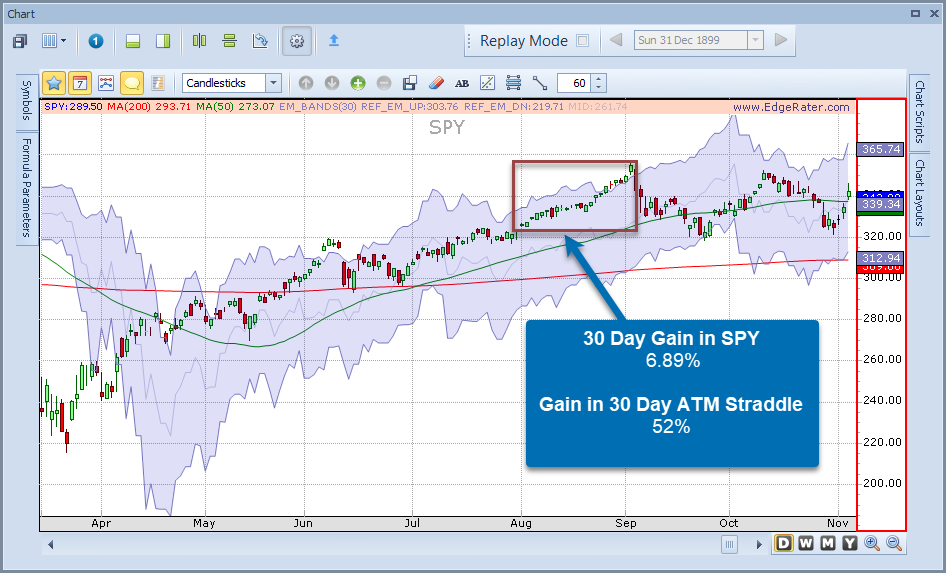
Chart showing the 30 day Expected Move Bands for SPY and gain in SPY vs gain in ATM Straddle for 8/3/2020 to 9/1/2020
In the highlighted period in the chart the bar on 9/1/20 closed outside the 30 day expected move bands. This time the 30 day gain in $SPY was 6.89% and the ATM Straddle that was initiated 30 days earlier on 8/3/2020 gained 52% in value.
Retail vs Professional Traders
Generally retail traders are mostly buyers of options and professionals mostly sellers. So, if a bar closes outside the expected move bands it can be thought of as a win for the retail trader! Bear in mind that the statistics show bars close inside the expected move 68% of the time so think about who’s mostly winning.
Getting a daily report on Expected Move
EdgeRater PRO 2020 has a new template in the Options Analysis Category called the Expected Move Template.

You can choose to get a report on one of the 12 available periods (or days to expiration) 3, 7, 14, 21, 30, 45, 60, 90, 120, 180, 360, 720. Run this template daily on a list of stocks that have weekly options (such as the CBOE Weeklies list) and you will see the following report:

The EdgeRater Expected Move Report showing all columns of information
The Expected Move Report Columns
Standard Report Columns:
Symbol:
The Symbol of the stock
Description:
The description of the stock
Date
The date of the bar that is being reported on
Close
The close value of the stock on the date
Vol
The volume of the stock on the date
Implied Volatility Columns
IV30
The Implied volatility for the chosen days to expiration. If the report is run for periods other than 30 days to expiration the heading will reflect that (eg: IV90)
IV30 Rank (count)
The Implied volatility rank based on the count of bars in the past year that had a lower IV. If the report is run for periods other than 30 days to expiration the heading will reflect that. eg: IV90 Rank (count).
IV30 Rank (range)
The Implied volatility rank based on current implied volatility within the range of highest high to lowest low implied volatilities in the past year. If the report is run for periods other than 30 days to expiration the heading will reflect that. eg: IV90 Rank (range)
Expected Move columns
Higher
$
The $ value of the higher expected move
Delta $
The difference between current close price and the higher expected move
%
The % difference of the higher expected move and current close price
Lower
$
The $ value of the lower expected move
Delta $
The difference between the lower expected move and the close price
%
The % difference between the lower expected move and current close price
Price in Relation To the EM Bands
Current In/Out
An In or Out indication. In if the stock closed inside the expected move, Out if it closed outside.
%EM
The location within the expected move bands of the close price. Similar in design to the %B value for Bollinger Bands.
1 Year % Inside
The % of time in the past year that price has closed inside the expected move bands.
EM Band Crosses
These columns indicate if price has crossed an expected move band
Cross Today
These columns indicate if price has crossed an expected move band today.
Above Upper
A Yes value if price crossed above the upper expected move band today.
Below Upper
A Yes value if price crossed below the upper expected move band today.
Below Lower
A Yes value if price crossed below the lower expected move band today.
Above Lower
A Yes value if price crossed above the lower expected move band today.
Bars Since Cross
These columns indicate the number of bars since price closed above or below the expected move bands.
Above Upper
Number of bars since price crossed above the upper expected move band.
Below Upper
Number of bars since price crossed below the upper expected move band.
Below Lower
Number of bars since price crossed below the lower expected move band.
Above Lower
Number of bars since price crossed above the lower expected move band.
Useful Ways to Use The Report
How can you use the report to your benefit?
Bear in mind that all EdgeRater reports are linked to charts and to other reports and so as you navigate around the report and select different stocks the chart will update to show that stock and also will include indicators that are appropriate for the report.
View Stocks With the Biggest Expected % Move
The default sort of the report is by % Expected move higher and so just by clicking on the top rows of the report you will see charts of the stocks with the biggest expected move.
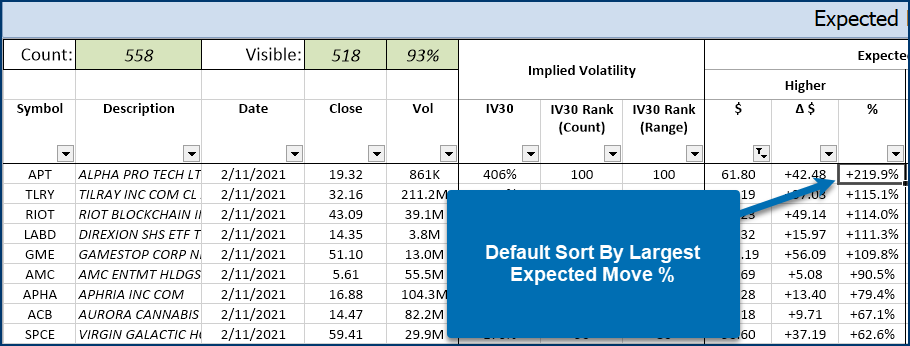
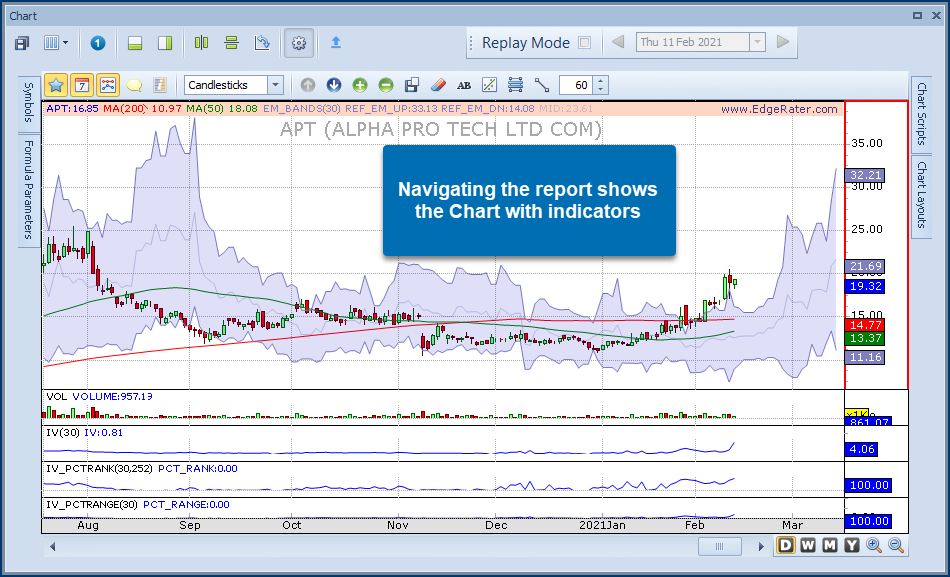
Note that I have chosen to expand the chart by 60 bars on the right hand side in order to see the expected move bands for future dates.
View Stocks That Crossed the Band Today
Another way to use the report is to view stocks that have just crossed the upper expected move band today. We’ve already discussed that crossing the expected move band is significant in terms of retail traders vs professionals. You can quickly see the stocks that crossed today and also the % of time in the last year that they have been inside their expected move bands. These are stocks to watch. Recent examples of $GME and $TLRY to name a couple of big movers first crossed their expected move bands before later going much higher.


View Stocks That Have Been Above The Upper Band The Longest
Another way to use the report is to sort by number of bars since a cross above the upper band. This will bring to the top of the list stocks that are currently in very strong moves.

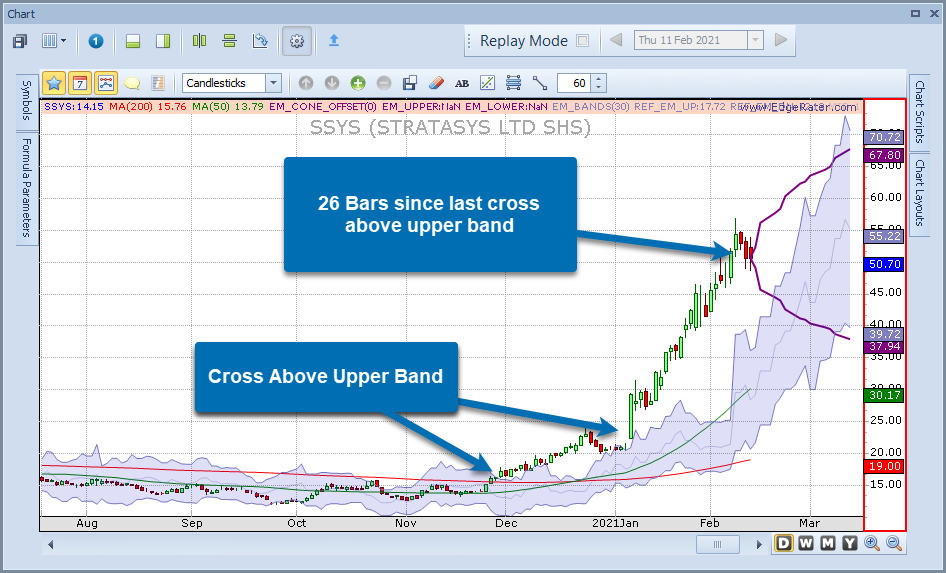
Summary
Expected move is a forecast of a future price range for a stock based on what price traders are trading the stock’s options at today. It is forward looking as it represents real money being bet on future outcomes.
EdgeRater has developed an indicator called EM Bands (Expected Move Bands) that are calculated based on implied volatility for one of 12 periods. These bands show where future expected move is and also allow you to view historically where price ended in relation to the expected move.
If you are buying at-the-money straddles you need price to close outside the expected move bands in order to make a profit. If you are selling straddles you need price to close inside.
Price tends to close inside the expected move bands 68% of the time. Each stock is different but the actual time spent inside the bands can be seen in the EdgeRater expected move report.
The EdgeRater expected move report is a great way to see where all stocks are in relation to their expected move. This report can be run for 12 different future expirations ranging from 3 days to 720 days.
Take the free 14 day trial of EdgeRater today to see which stocks are making the list right now.

0 Comments